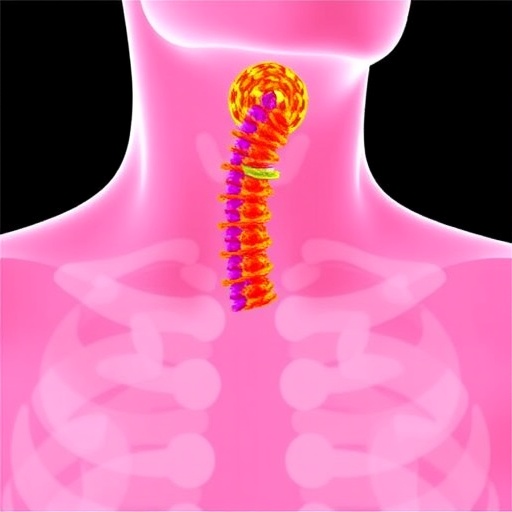Recent advances in cancer immunology have spotlighted the critical role that tertiary lymphoid structures (TLS) play within the tumor microenvironment. These ectopic lymphoid aggregates, which develop at sites of chronic inflammation, have now been recognized as dynamic centers for local immune activation. In a groundbreaking meta-analysis published in BMC Cancer, a research team led by Yu et al. meticulously dissected the prognostic and clinicopathological impacts of TLS in esophageal squamous cell carcinoma (ESCC), offering novel insights into how these structures could inform patient outcomes and therapeutic strategies.
Esophageal squamous cell carcinoma remains a formidable clinical challenge, owing to its aggressive nature and often late-stage diagnosis. Traditional prognostic markers center on TNM staging, yet these fail to fully capture the complexity of host-tumor immune interactions. The study under review aggregates data from seven distinct studies encompassing nine datasets, utilizing rigorous statistical models to parse the relationship between TLS presence, tumor staging, and survival metrics such as overall survival (OS) and progression-free survival (PFS).
Their meta-analysis compellingly demonstrates that TLS presence correlates with more advanced T stage, exhibiting an odds ratio of 2.65, indicating that tumors with TLS are over two and a half times more likely to present at a higher T stage compared to TLS-negative tumors. Interestingly, the presence of TLS did not correlate significantly with nodal involvement (N stage), rendering this immune microenvironment feature somewhat independent of lymphatic spread.
Beyond staging correlations, the prognostic implications of TLS were profound. Patients harboring TLS within their tumor tissues exhibited dramatically improved OS and PFS, with hazard ratios of 0.49 and 0.56 respectively. These statistics suggest that TLS presence halves the risk of mortality and disease progression in ESCC patients, a transformative insight that may reframe clinical risk assessment paradigms. Crucially, the robustness of these associations was accentuated when TLS detection employed combined hematoxylin and eosin (HE) staining alongside immunohistochemistry (IHC), lowering hazard ratios further to 0.40 for OS and 0.50 for PFS.
From a mechanistic perspective, the study reaffirms the hypothesis that TLS function as in situ lymphoid organs, orchestrating coordinated adaptive immune responses against tumor antigens. Comprised of distinct T-cell zones, B-cell follicles, and specialized antigen-presenting cells, TLS may foster effective tumor antigen presentation and immunological memory formation. This architectural complexity likely underpins the survival advantage seen in patients with TLS-positive ESCC, reflecting a more immunologically vigilant tumor microenvironment.
The clinical ramifications of these findings are manifold. Currently, immunotherapies such as immune checkpoint inhibitors have revolutionized treatment for various malignancies but show variable efficacy in ESCC. The identification of TLS as a biomarker could refine patient stratification, identifying individuals more likely to respond favorably to immunomodulatory treatments. Additionally, the apparent independence of TLS presence from nodal status suggests that immune microenvironment signatures could supplement or even supersede traditional pathological staging in certain contexts.
Nevertheless, this meta-analysis underscores the critical importance of standardized TLS assessment methodologies. Variations in TLS identification criteria across studies complicate direct comparisons. The enhanced prognostic power detected with combined HE and IHC techniques advocates for integrative diagnostic protocols, harnessing both morphological and molecular markers to accurately characterize TLS.
Future research avenues will need to unravel the precise molecular cues governing TLS formation and maintenance within ESCC. Understanding these pathways could unlock strategies to therapeutically induce TLS neogenesis, thereby converting “cold” tumors with poor immune infiltration into “hot” tumors amenable to immunotherapy. Intriguingly, the evolving landscape of tumor immunology may benefit from integrating TLS-targeted approaches with existing checkpoint blockade agents, potentially synergizing anti-tumor immunity.
Moreover, the broader implications of TLS extend beyond ESCC into other epithelial malignancies where immune microenvironment cues dictate clinical outcomes. This comprehensive meta-analysis strengthens the paradigm that tumor-infiltrating immune structures serve as essential arbiters of cancer progression and patient survival, advocating for their incorporation as core components in oncological diagnostics and prognostics.
In sum, Yu and colleagues deliver compelling evidence that tertiary lymphoid structures are not mere bystanders but pivotal players shaping the clinical trajectory of esophageal squamous cell carcinoma. Their presence portends improved survival and highlights the nuanced interplay between tumor biology and host immunity. As oncology moves toward precision medicine, TLS stand out as a promising biomarker and therapeutic target, heralding a potential shift in how ESCC is evaluated and treated.
The synthesis of these data offers renewed optimism for ESCC patients and clinicians alike, emphasizing the power of harnessing endogenous immune architectures within tumors. With further validation and clinical translation, TLS could fundamentally alter the prognostic landscape and therapeutic decision-making for this formidable cancer type.
Subject of Research: Prognostic and clinicopathological significance of tertiary lymphoid structures in esophageal squamous cell carcinoma
Article Title: Prognostic and clinicopathological significance of tertiary lymphoid structure in esophageal squamous cell carcinoma: a systematic review and meta-analysis review
Article References:
Yu, Ct., Gao, Y., Liu, Ry. et al. Prognostic and clinicopathological significance of tertiary lymphoid structure in esophageal squamous cell carcinoma: a systematic review and meta-analysis review. BMC Cancer 25, 1544 (2025). https://doi.org/10.1186/s12885-025-14997-x
Image Credits: Scienmag.com
DOI: https://doi.org/10.1186/s12885-025-14997-x
Tags: chronic inflammation and canceresophageal cancer prognosisesophageal squamous cell carcinomahost-tumor immune interactionsimmune activation in tumorsmeta-analysis of cancer studiesoverall survival in cancerprognostic markers in esophageal cancerprogression-free survival metricstertiary lymphoid structuresTLS and patient outcomestumor microenvironment immunology





